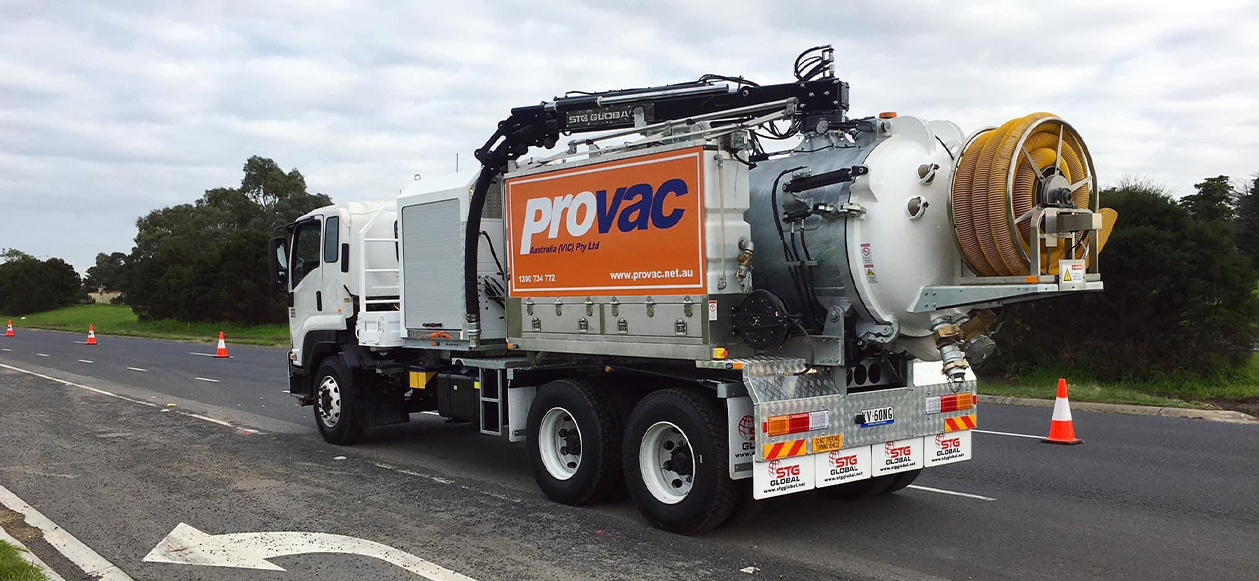Our Services Provac Australia (VIC)
We offer underground service locating & hydro excavation services to Victoria
Services include:
Non-Destructive Digging (NDD) – Vacuum Excavantion
We have hydro vacuum excavation trucks which is a form of non-destructive digging (NDD). They use a pressurised water system to break up soil, gravel and other earth materials. A high-flow vacuum then sucks the dirt up and stores it inside the truck – ready to be dumped appropriately.
Ground Penetrating Radar (GPR)
The GPR technology allows you to find what is beneath your feet. The technology can detect anything from structures, utilities, water, voids, rock and more. It works by sending electromagnetic radiation waves into the ground to detect what’s below you. The signal is send back using a receiving antenna which will produce readable data so that you know anything you should about the subsurface factors.
Underground Service Locating
Don’t worry if there are any buried pipelines or cables, the underground service locating technology from Provac will find them. This technology uses electromagnetic frequencies to locate underground service lines so that you can dig or drill down without damaging any service lines.
Prior to any work on both private and public property, you have a legal requirement to contact Before You Dig Australia and ask for any plans of underground services in the area you intend to drill or dig in. Failing to do so, can leave you liable for any damage and costs.
Our Services
Get in contact
Fill out the form below to obtain obligation-free advice, proposals and tenders.
Frequently Asked Questions
What are the benefits of non-destructive digging?
Non-destructive digging, also known as vacuum excavation or hydro excavation, is a technique used to safely and efficiently excavate soil without causing damage to underground utilities, structures, or the surrounding environment. Here are some benefits of non-destructive digging:
- Damage prevention: Non-destructive digging prevents damage to underground utilities and structures.
- Safety: It improves worker safety and reduces accidents.
- Efficiency and speed: It allows for faster project completion and reduces disruptions.
- Environmental protection: It minimises soil disturbance and reduces the environmental impact.
- Cost savings: It prevents expensive utility repairs and offers long-term cost savings.
- Accuracy and precision: It provides high accuracy and avoids accidental damage.
Non-destructive digging offers safer, faster, and more environmentally friendly excavation, protecting underground infrastructure while minimising costs and disruptions.
What are non-destructive methods for digging?
Non-destructive methods for digging, also known as non-destructive excavation or subsurface utility engineering (SUE) techniques, involve using specialised equipment and tools to excavate soil without causing damage to underground utilities or structures. Here are some common non-destructive methods for digging:
- Hydro Excavation: Uses high-pressure water and a vacuum to break up and remove soil around utilities.
- Air Excavation: Utilises compressed air to loosen and extract soil, suitable for restricted water usage or freezing temperatures.
- Soft Digging: Manual excavation with hand tools for precise digging around utilities in limited spaces.
- Ground Penetrating Radar (GPR): Non-intrusive method that uses radar pulses to locate underground structures and utilities.
- Vacuum Extraction: High-powered vacuum system to remove loose soil and debris without damaging utilities.
- Auger Boring: Trenchless method for creating underground tunnels while installing pipes or conduits.
These non-destructive methods for digging provide safer, more controlled excavation options that minimise the risk of utility damage and ensure efficient project execution. They are particularly beneficial in urban areas or locations with complex utility networks where accuracy and precision are crucial.
How does an NDD truck work?
An NDD (Non-Destructive Digging) truck, also known as a vacuum excavation truck or hydro excavator, is a specialised vehicle that combines high-pressure water and vacuum systems to perform non-destructive digging. Here's how an NDD truck typically works:
- Water System: The truck has a water tank, pump, and hoses. High-pressure water breaks up the soil.
- Digging: The operator directs the water onto the target area, loosening the soil and creating a slurry.
- Vacuum System: The truck has a debris tank, suction fan, and hoses. The vacuum system sucks up the soil and water slurry.
- Soil Extraction: Solid material is separated from the water using filters or separators in the truck.
- Disposal: The excavated soil and debris are transported for proper disposal or recycling.
- Utility Protection: Operators take precautions to avoid damaging underground utilities, using visual inspection or technologies like GPR.
NDD trucks offer safe and efficient excavation, minimising utility damage and enabling controlled digging and soil removal.
Why is it essential to dial before you dig?
Dialling before you dig is essential for safety, legal compliance, and efficiency in excavation projects. It helps prevent accidental damage to buried utilities like gas lines, water pipes, and electrical cables, which could pose significant safety risks, result in costly repairs, and disrupt essential services. Complying with this practice not only safeguards human lives and the environment but also demonstrates professionalism and adherence to industry best practices, ensuring that projects are carried out safely and efficiently while avoiding legal consequences and service interruptions.
What information can be obtained from the dial before you dig?
When you dial before you dig, you can obtain crucial information for your excavation project, including the locations, depths, and ownership of underground utilities like gas pipelines, water mains, electrical cables, and telecommunications lines. This information is essential for preventing accidental damage to utilities, ensuring worker safety, and complying with legal requirements. The service may also provide safety guidelines, mark the ground with colour-coded flags, offer contact details for utility companies, specify a validity period for the information, and provide additional resources for excavation safety, ultimately helping you plan and execute your project efficiently and safely while avoiding costly disruptions and repairs.
How do you detect underground services?
Detecting underground services requires a combination of methods, including professional utility locating services equipped with ground-penetrating radar and electromagnetic locators, obtaining utility maps and records, using metal detectors and visual cues for metallic utilities, employing soil probing cautiously, and considering vacuum excavation or borehole inspection when necessary. Ground disturbance permits and cooperation with utility companies may also be essential. Accurate detection of underground services is crucial to prevent accidents, damage, and service interruptions during excavation projects, with safety and compliance being top priorities in this critical process.
Victoria Division
- Monday - Sunday: 24 Hours




















































